The plenary session of the 2nd International Tiger Forum entitled ‘The Status of the Global Tiger Recovery Programme Implementation from 2010 to 2022’ took place on 5 September – the opening day of the Eastern Economic Forum.
Russian President Vladimir Putin sent a video address to Forum participants: “The total number of these exceptionally beautiful predators has grown by 40 percent globally since 2010. We in Russia also have something to be proud of. Twelve years ago, there were no more than 390 adult Amur tigers in our Far Eastern taiga. Now there are about 750 of them, including cubs. This is the result of systematic measures implemented at the state level, but above all, a tangible result of the coordinated, hard work of Russian scientists, enthusiasts, and environmental organizations.”
The Forum was attended by relevant ministers from tiger range countries. During the professional dialogue, experts, ecologists, and scientists discussed the results of the 12-year programme for the conservation of the Amur tiger, outlined new guidelines and discussed mechanisms for regular information exchange and effective international coordination.
In his speech, Konstantin Chuichenko, Minister of Justice of the Russian Federation and Chairman of the Supervisory Council of the Amur Tiger Centre, noted that over the past 10 years the number of Amur tigers killed by poachers in Russia has decreased by three times. According to Mr. Chuichenko, these results have been achieved thanks to amendments made to Russian legislation. “The goal is to expand the range of the Amur tiger and get closer to its previously existing boundaries. Our main achievements consist in the fact that we have created a serious system of protection, first of all, for the Amur tiger,” said the Head of the Russian Ministry of Justice.
Alexander Kozlov, Russian Minister of Natural Resources and Environment, also spoke about the measures needed to ensure that the Amur tiger population in the Russian Far East does not decline. The Minister noted that the introduction of the SMART spatial monitoring programme by seven countries (Bhutan, India, Indonesia, Cambodia, China, Nepal, and Russia) has made it possible to establish relations between law enforcement agencies of the countries.
“The tiger population in the Far East is not only conserved, but it is also growing thanks to the persistent policy of the state, public and scientific organizations and people who do not necessarily live in the Far East,” said Mr. Kozlov. The Minister also emphasised that a quarter of the tiger’s range is covered by national parks and nature reserves.
Somphot Duangchantrasiri, a representative of the Kingdom of Thailand’s Ministry of Natural Resources and Environment, said there were about 150 to 180 Amur tigers in the country. “The population is quite stable and even increasing slightly. We hope that we will be able to maintain all these numbers,” the scientist added. According to him, one of the threats to the Amur tiger remains the lack of foraging grounds in some of Thailand’s forested areas.
Ambassador Extraordinary and Plenipotentiary of the Democratic People’s Republic of Korea to Russia Sin Hong-chol said in his speech that North Korea is looking forward to cooperating with Russia on tiger conservation, including sharing experience. “The government of our Republic will continue to strive to strengthen regional and bilateral cooperation with Russia and China to conserve and return tigers to their habitats,” said the ambassador.
During the Tiger Forum, Alexander Kozlov, Russia’s Minister of Natural Resources and Ecology, and Aliya Shalabekova, Kazakhstan’s Vice Minister of Ecology, Geology and Natural Resources, signed an agreement to reintroduce the tiger to Central Asia. A protected area has been established in Kazakhstan for this purpose in the Lake Balkhash area, and the first generation of the population will consist of Amur tigers that could be brought in from the Primorsky Region. The Amur Tiger Centre will assist in the project.
The event was organized by the Roscongress Foundation, the Ministry of Natural Resources and Ecology of the Russian Federation, the Ministry of Justice of the Russian Federation, and the Amur Tiger Centre.






